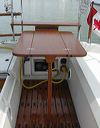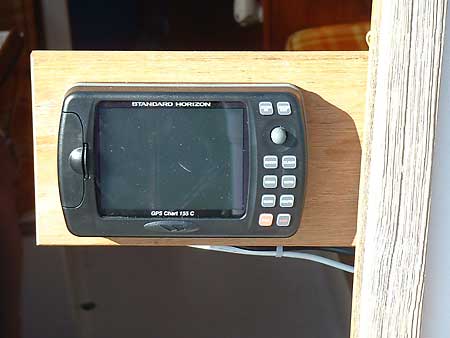
Various Projects – On Deck
Various Projects is a catch-all for ideas and isolated bits of creativity that can be explained in a picture or two and a few words. Originally one section, it's become popular enough that it has had to be split in two – On Deck and Below. The split is imprecise. The engine, for instance, is accessed from down below, but because it's controlled from above, it has been arbitrarily plumped in with deck improvements. Similarly a shelf over the fuel tank might seem properly to belong with other stowage ideas, but this shelf is for deck gear, so it's lumped with deck improvements. Far be it from this site to suggest that sailing – which we all know to be a mirror of all human existence – is less untidy or more consistent than it is.
Additional information
Spreaders – A 27 spreader slides into a round receptacle, part of a mast fitting that also secures the lower shrouds. Between the spreader itself and the mast fitting is a piece of rubber hose that provides some elasticity in the mounting. With age, this hose will deteriorate to the point where it no longer provides support to the spreader (the spreader should not move more than an inch or so fore and aft or rig tension will be inconsistent from tack to tack; extreme sloppiness could conceivably damage the spreader). You must remove the spreader and replace the hose as Ken Pole did, or find some slightly elastic material to fill the gap, as in the photo Spreader Base above.
"After an extensive search, I found suitable heater hose for the inboard end of my Mark III's spreaders at a truck supply shop. It has an outside diameter of about 1-5/8" and a wall thickness of about 3/16". My spreaders are 1" aluminum pipe which has an O.D. of 1-5/16" so the hose is a snug fit. It costs $2 an inch up here and you'll need no more than 5" to do both sides." – Ken Pole, Santiva
Projects more easily described than photographed
Shroud rollers – The forward lower shrouds on a 27 tend to hang up the clew of a tacking genoa and they don't do the fabric much good either. Nick Genco of Genco Marine didn't have a source for shroud rollers but he had an idea. "Use plastic electrical conduit." Five dollars later, I had two 6-foot lengths of grey electrical conduit with an inside diameter of about 3/4 inch. Originally they were capped top and bottom by the ends intended for small turnbuckle boots. These didn't stand up to the repeaded impacts so the lower ones were replaced with s/s fender washers sized to the wire diameter (these are split by sawing and bent to slip over the wire). No more hang-ups and there seems to be much less abrasion of the clews of headsails.
Whisker pole – A proper whisker pole is about $500; Towser's whisker pole cost $70. It consists of a large dinghy spinnaker pole end fitting (about $30), a foot-long piece of 1-inch diameter aluminum tubing (scrounged) and a 12-foot extendable painter's extension pole (about $30). The fitting is screwed in the tubing and the tubing is epoxied to the end of the painter's pole. The outboard end (the screw fitting for a paint roller) fits nicely in the clew of the sail. Being relatively thin, the pole bends like mad, but it's light, it's easy to handle and it works.
Rudder post – The action of steering causes the bolt hole at the top of the rudder post to elongate; the same wear may be found on the tiller bolt holes, particularly if the bolt is not kept tight. There are two possible long-term solutions. The simplest, used on Aragorn, is to install an M8 metric bolt, which is a hair larger than the original Imperial/SAE size bolt. The other, used on Kat's Paw I, is to weld a length of tubing with the inside diameter equal to the bolt diameter in the place of the bolt hole. You will need to take the rudder to a machinist for this. Take the tiller at the same time and ask him to install bushings to take out any slop in its holes.


















